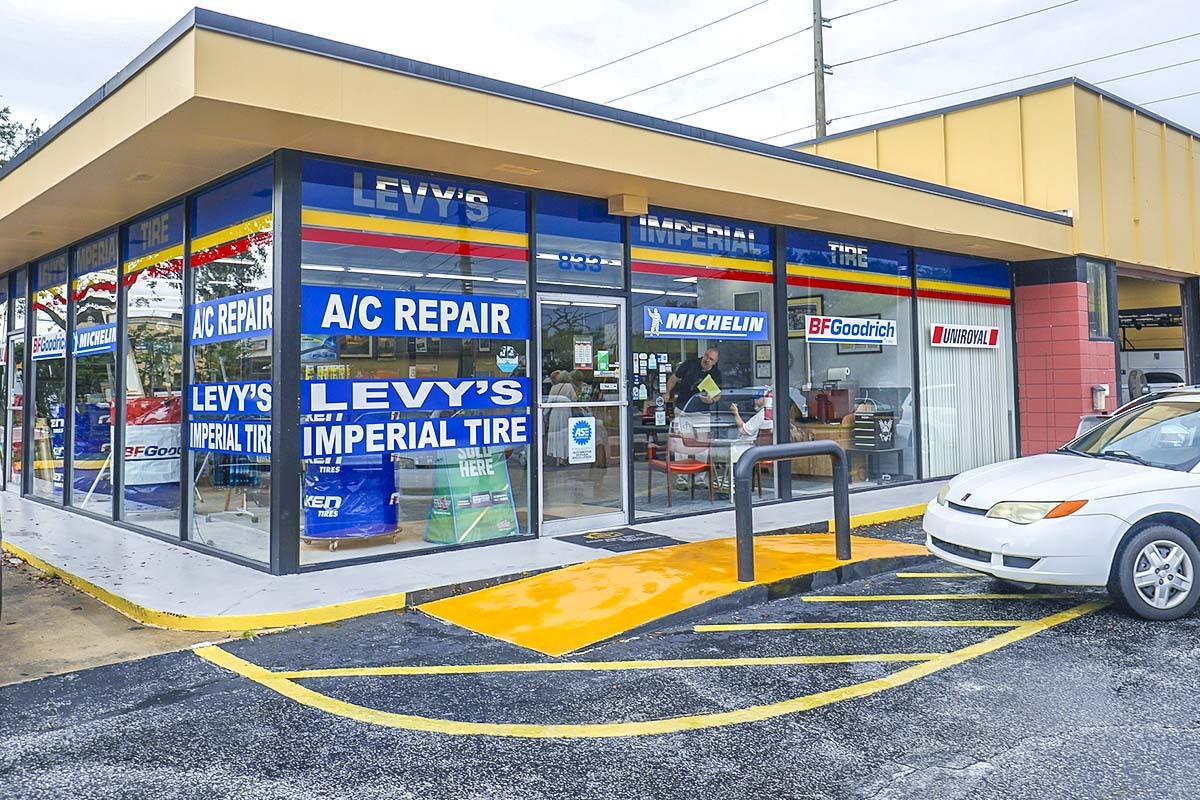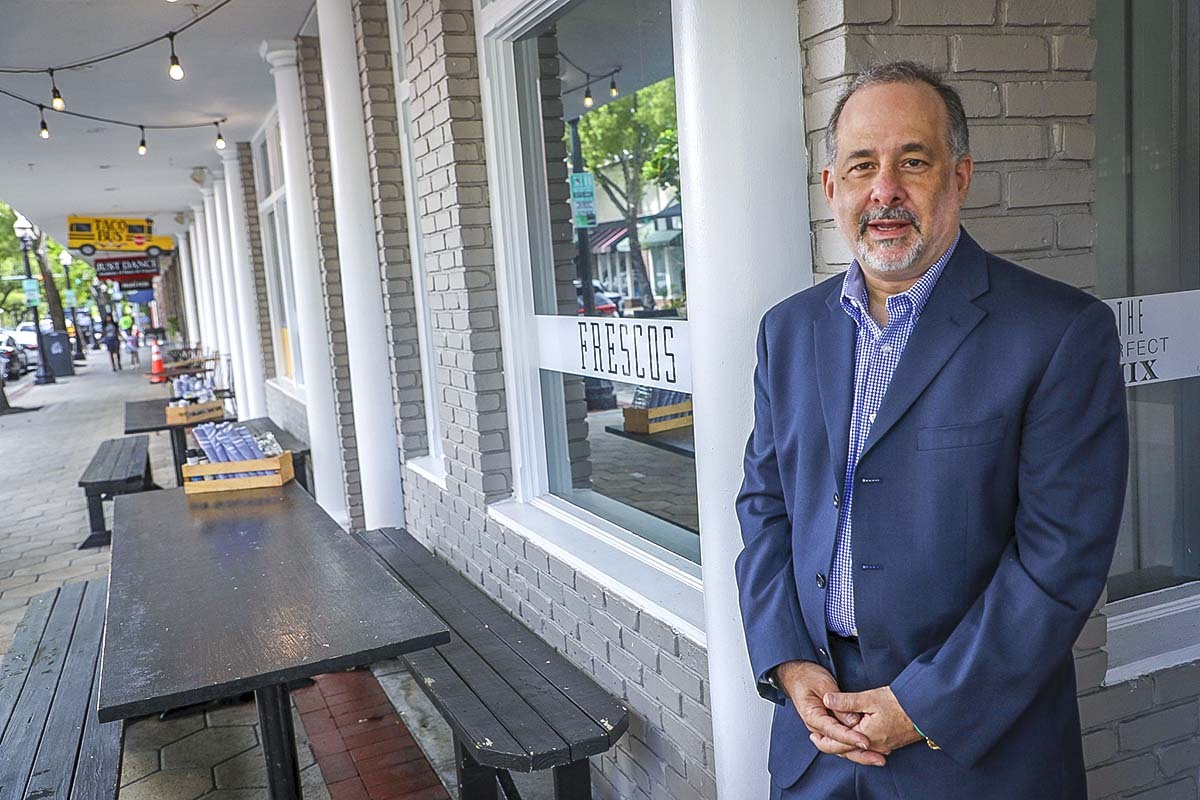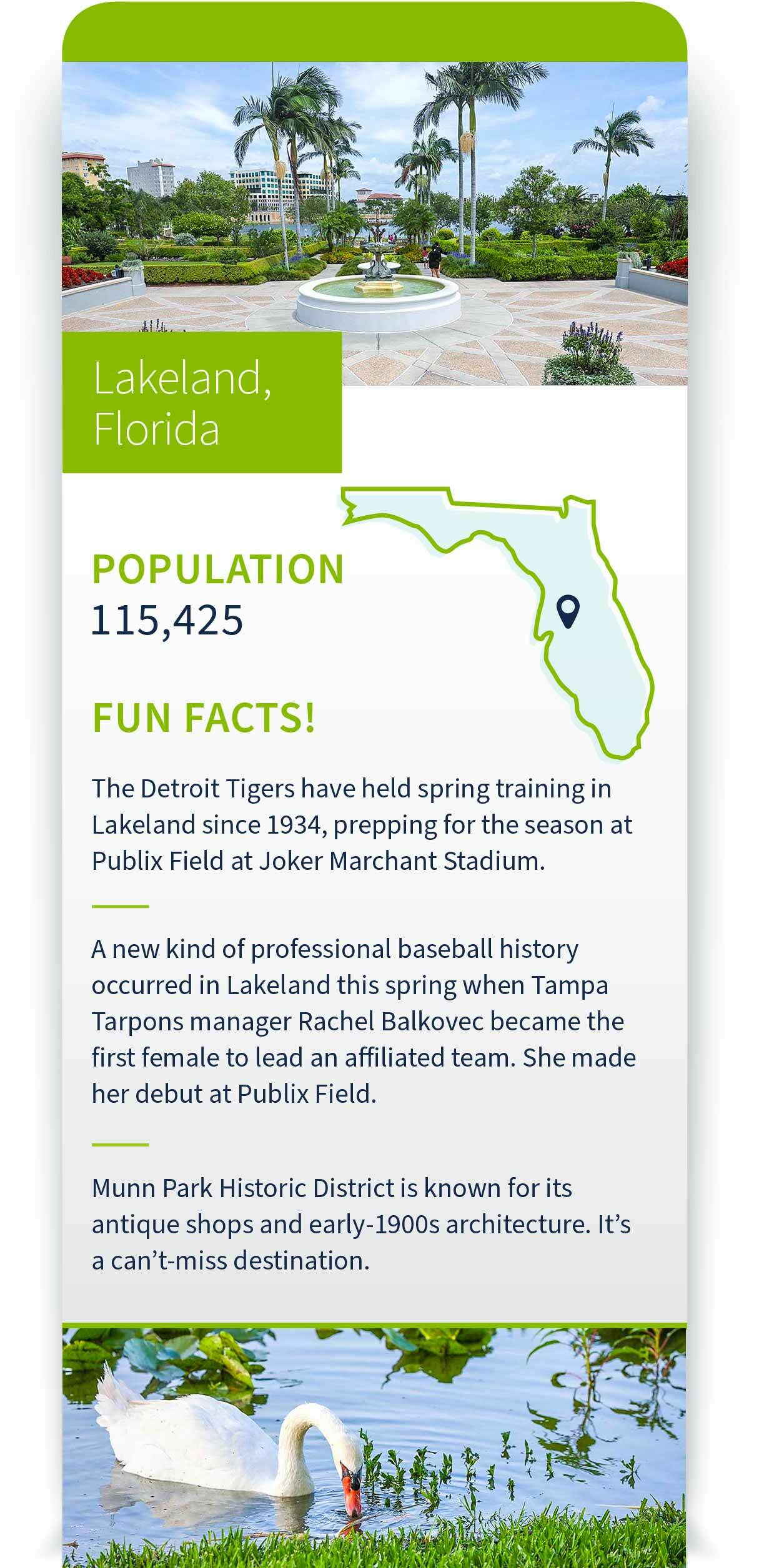Located east of Tampa, on the way to Orlando, one can find a land of our latest Good Town. It’s a land of enchantment. Or, as locals call it, Lakeland. It’s Old Florida, with palm trees and mossy oaks, lakes seemingly in every neighborhood, a strollable, inviting historic business district and people constantly on the move – walking, running, biking or skateboarding.
The Seminole nation once lived here, totaling nearly a half million in population until the Spanish conquistadors arrived. More modern history dates back to after the Civil War, when a new town emerged alongside a railroad terminal.
So where do we start our journey? At Levy’s Imperial Tire and Service Center, of course. On the edge of downtown, Levy and Gloria Harrison have been small-business fixtures for decades, combining dependable service with art.
That’s right. As customers wait for their car to be serviced, they sit in a wing of the reception area that includes dozens of paintings of landscapes – 10 of which are original Florida Highwaymen works. The Highwaymen rose to fame in the mid-1950s, and Levy’s connection is to one of the most famous artists of the group, Robert Butler.
“He and I met in April 1986,” Levy explained. “He needed a leaky tire repair, and I really admired his work. I’d always wished I could do something like that.”

The front of Levy's gives no hint of the magic inside. / GARY TRAMONTINA PHOTOS

Levy's Imperial Tire & Auto Service is known for dependable business and breathtaking landscapes.

While customers wait for their car to be serviced they can check out the art gallery in Levy's reception area.

Harrison shows off an autographed book of Florida Highwaymen art.

Levy Harrison, businessman and artist.

Levy Harrison gives a visiting reporter the background on his favorite pieces.

A customer takes in the artistic offerings as Harrison holds court.
When Butler mentioned classes, Gloria signed her husband up. The ritual lessons started at 6 p.m. and lasted past midnight. By 1993, Levy was doing the teaching, turning his reception area into a night-time studio.
Levy beams as he shows off the paintings on the wall. There’s one from Mary Ann Carroll, the only female member of the famous group, who painted on the spot during a visit to the tire store/art museum. He traded her two new Michelin tires for possession of the work.
Perhaps the most prized painting is one Levy and Butler worked on together during a 1991 art show. It’s called “Florida in the Pines,” and it brings a Florida summer morning to life with the hint of evaporating fog.
In an age of Jim Crow restrictions, the Highwaymen made their reputation by traveling across the state – and soon, the South – selling their paintings. Robert Butler became one of the most famous not merely because of talent, but an engaging personality.
“Robert would have four or five canvasses out, then he’d have kids put paint on each one,” Levy explained. “Then he’d go create five different scenes, load the paintings in the station wagon and hit the road to make rent money.”
While Levy shows off the art to visitors, Gloria manages the steady flow of customers. They’ve maintained this peaceful, loving existence for 59 years of marriage – and 42 years of business. “He’s a natural-born teacher,” she said with a loving gaze. “And I handle the business end.”

Regions' banker Michael Greenberg welcomes visitors to brunch at Frescos. / GARY TRAMONTINA PHOTOS

Michael Greenberg and Brenda Powers provide visitors the perfect start-me-up to a Lakeland tour.

The salad and sandwich combo at Nineteen61 offers great Latin-infused cuisine with a modern twist.

For 40 years, Texas Cattleman Company has been the go-to destination for steak lovers.

How can you go wrong with an iconic sign that everyone in Central Florida loves?

Mr. Fish keeps it simple - and delish.

The lines to order food at Mr. Fish start even before they open for business.
‘It’s Impossible to Find a Bad Meal’
Located on the corner of Kentucky and Lemon, Frescos Southern Kitchen & Bar provides the perfect place to refuel with an old-fashioned breakfast. We chose the House Cinnamon Bread, while others opt for Biscuits and House Sausage Gravy and a bowl of breakfast staples.
“My husband and I celebrated our anniversary here,” said Brenda Powers, the branch manager for Regions in Lakeland. “This is a very popular place. Their weekend brunch is so popular often times you can’t even get in.”
Frescos started as a coffee shop, then expanded over the years. Now, it’s not only a foodie destination but a part of the community raising funds for the American Cancer Society.
Originally from Baltimore, Michael Greenberg came to Central Florida to work as a Consumer Banking manager for Regions Bank.
“What I love about Lakeland is the small-town feel, the history and architecture,” Greenberg said. “You can’t go anywhere without running into someone you know, but it’s close enough to Orlando that you can live here and enjoy everything there without the daily, big-city hassles.
“And, here, it’s impossible to find a bad meal.”
Over the next couple of days, we discover that. At the original Texas Cattle Company, we feast on aged, grain-fed steaks cooked over a wood-burning fire containing Florida citrus and oak. As good as the food is, the personal service is even better.
Since 1968, Mister Fish has been the go-to place for quick seafood and chicken meals based in its original structure. Parking is at a premium. For more upscale fare, we headed downtown for succulent oysters and salmon at Fish City Grill.
Michael Greenberg nailed it. The foodie options are endless.

The historic marker notes that the Florida Southern College has the largest collection of Frank Lloyd Wright buildings. / GARY TRAMONTINA PHOTOS

The original Annie Pfeiffer Chapel was finished by Frank Lloyd Wright in 1941.

Frank Lloyd Wright's vision for Florida Southern College's campus remains mesmerizing 80 years after he first created the designs.

Walkways at Florida Southern are lower than they look. That's by design, to keep people moving to open spaces.

A young professor heads for home after the conclusion of another week at Florida Southern College.

The design of the future, as Frank Lloyd Wright first envisioned campus life in the 1930s.

Water features blend so well with Wright's other designs.

Sun, shade, cement and greenery. All natural elements play into Wright's designs of the Esplanade.

University President Ludd Spivey gave Wright free reign in recreating the campus.

Familiar lines. Unfamiliar access. Wright's unique designs hold up nearly a century later.
The Wright Stuff
In the heart of Lakeland, straddling the north side of Lake Hollingsworth, Florida Southern College has provided private, higher education options since 1852 (originally as a Methodist seminary). But what sets this picturesque campus apart is the connection to America’s most revered architect.
In 1938, Florida Southern President Ludd Spivey was looking to accomplish two things: help his struggling college out of the depths of the Great Depression while overhauling the aesthetics. He reached out to 71-year-old architect Frank Lloyd Wright, who had just finished his masterpiece, Fallingwater, in Pennsylvania. Spivey’s pitch: Come to Lakeland and reinvent Florida Southern College.
To everyone’s surprise, Wright accepted the offer and began a 20-year commission. He designed 18 campus buildings and a model home for faculty and staff.
“President Spivey was trying to keep the school alive,” said Jack Coffey, our tour guide. “The traditional layout included Jeffersonian buildings around a quad. But Spivey wanted something unique, something that put the college in the public eye.”
Wright’s work continued until the advent of the space age, building 12 designs from his original master plan despite limited funding. They included academic buildings, connected walkways, a library and a planetarium.
Perhaps the most unique building of all wasn’t constructed until the 21st Century. The Usonian Faculty House, initially designed in 1939, offers an open-floor plan with environmentally sustainable concrete and Florida Cypress to provide what Wright envisioned as the future home for Florida Southern’s staff.
“The Usonian style was the successor to his prairie style,” Coffey said. “It was meant to be cost efficient while providing the most marketable, ideal design for the American family. Cypress wood was Wright’s preference because in the early ‘30s it was easily available. Now, of course, it’s difficult to find and quite expensive.”
Daily tours of the Usonian Faculty House and the 12 campus structures are worth the time and investment but call ahead and reserve your spot.

The neoclassical gardens are part of the Lake Mirror Promenade. / GARY TRAMONTINA PHOTOS

The water fountain frames Lakeland's gorgeous botanical garden, where admission is free.

Looking away from the lake at the Hollis Garden courtyard.

Hollis Garden features an array of eye-popping flowers.

Living, breathing swans are everywhere in Lakeland, but their natural beauty and sleek curves mean no one takes them for granted.

Two gray swans share a romantic meal together.

Bobbing for minnows, a local swan starts off the day with breakfast.

Another swan takes flight outside Lake Mirror.

Sculpted swans frame another view of luscious Lake Mirror.

Covering 18 acres of downtown, Lake Mirror offers unlimited vantage points.

A mid-afternoon stroller gets some Vitamin D and stress relief at Lake Mirror.

The Silver Moon Drive-In has been running double features on steamy summer nights since 1948.

The Publix birthday cake water tower stands above the grocery store's Lakeland headquarters.
Melt Your Troubles Away
On the edge of Lake Mirror in the middle of Lakeland’s city center, Hollis Garden offers a late-afternoon respite. Admission is free to this botanical wonder, which covers 1.2 acres and offers lush ferns, tropical plans, a Koi pond and waterfalls. A few minutes strolling the grounds instantly melt life’s troubles away.
On the nearby promenade that encircles the lake, Carole Castillo strolls with kids in tow. She lives an hour away, but visits often.
“My parents live in Lakeland, and I love the atmosphere here,” Castillo said. “It’s free, it’s beautiful and it gets the kids out into nature and away from their iPads. There’s so much do here, especially on the weekends and the 4th of July.”
There’s so much to do any direction you go in Lakeland. At Lake Morton, where the renowned Polk Museum of Art at Florida Southern College beckons newcomers, swans have been a fixture for the past 100 years. In fact, they are so iconic, Lakeland is known as Swan City.
For those who want to relive their childhood, the Silver Moon Drive-In has remained a two-screen community fixture for 75 years. And, with just a turn of your head as you wait to be admitted, you can spot another Good Town Lakeland icon, the Publix Birthday Cake Water Tower rising above the grocery chain’s corporate headquarters.
But we get a call from a newly discovered old friend. One of the Florida Highwaymen’s descendants is holding court downtown, so we’re headed back to Levy’s Imperial Tire and Service Center.

Like his father before him, Daniel Butler has become a painting legend. / GARY TRAMONTINA PHOTOS

Daniel Butler offers insight to a favorite painting.

Butler's passion is obvious as he shares his story with a reporter.

No, you're not seeing double. You can find murals on nearly every corner downtown.

The entrance at Southgate Shopping Center may be familiar to fans of the movie Edward Scissorhands as one of the film's iconic locations.

The Detroit Tigers made Lakeland their spring training home in 1934. They first moved to Joker Marchant Stadium in 1966.
Artist in Residence
Daniel Butler is the second of Robert Butler’s nine children, and he has emerged as a respected artist in his own right.
“When you think about the talent and education my father had, how can you raise kids doing this?” Butler asked, showing off the gallery of paintings. “You don’t stop painting. You can’t stop.”
Daniel Butler was working in Savannah, Georgia, when his father passed, and Levy beckoned him to come home to Lakeland. He now paints regularly at the tire store, sharing the stories of the Highwaymen with a new generation while ensuring the legacy continues through his own stunning works.
“We are doing the same thing as the original Highwaymen, with the internet being the only difference,” Butler said. “You still have to get around to sell your paintings.”
Butler tried roofing once. “I went up four, five stories one time. The next day, I started painting again. It was much better for my health.”
He survived a health scare of his own, one that left him in a coma for seven months awhile back. The first thing he did when he awoke? He went straight to an easel and began painting. The painting was flawless but lacked his artistry. The message, however, was clear: he hadn’t lost a thing.
“Technically, it wasn’t me on that canvas. Not the first time. But it was my way back,” he remembered.
Like his father, Daniel Butler has forged a familial relationship with Levy and Gloria Harrison. The tire shop offers a place to create and show off the results. With the same outgoing personality and charm, it’s as if Robert Butler never left.
“My dad never stopped painting, so I’ll never stop,” Butler said. “To do so would disrespect what he did. I’ll never be nonchalant after inheriting this legacy, and with Mr. Levy pushing me I’ll never step away.”
Each day, he ensures and expands on the legacy of the Highwaymen and his father. But it’s not just the mesmerizing art that takes you deep into the forests and swamps of Florida.
It’s the state of mind.
“When Robert Butler painted in the woods, he’d take a deep smell of the air with every three steps he’d take. He’d test the ground. He took it all in. And his paintings take you all in until you’re immersed and a part of what he saw, felt and created.”
